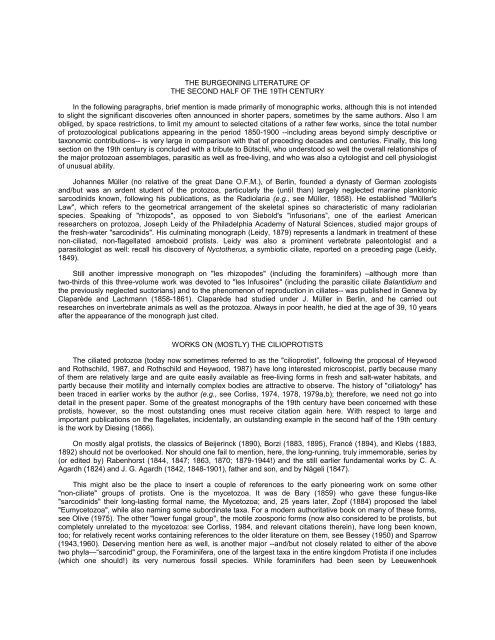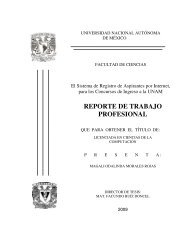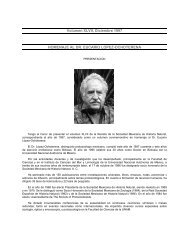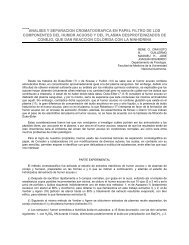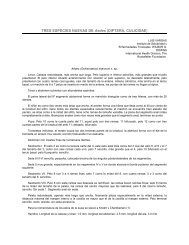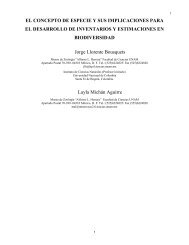Acephalina (for one subgroup of the gregarines) sporozoa have been assigned to still earlier workers, viz., Dufour(1828) and von Kölliker (1848), respectively. The Trypanosomata is a name proposed by Kent (1880-1882); and, asmentioned above, the Haemosporidia has long had its authorship assigned to Danilewsky (1885). The nameMyxosporidia is first found in Bütschli's (1880-1882) opening volume on the c<strong>la</strong>ssification of all the protozoa; andBalbiani (1882) erected the Microsporidia. Workers of the 19th century involved in additional names, generally oflower ranks or of lesser importance than the taxa just listed above, inclu<strong>de</strong> Caullery and Mesnil, Doflein, De<strong>la</strong>ge andHérouard, Lankester, Schaudinn, and Stolc.NEW FINDINGS OR IDEAS INVOLVING FREE-LIVING PROTOZOAAs intimated above, the outline of most major groups of the protozoan protists that are predominantlyfree-living (or symphoriontic in nature, attached to the bodies of other organisms primarily for transport)was established well before the middle of the 19th century, while whole assemb<strong>la</strong>ges of the more difficultto study parasitic forms had to await first discovery in the <strong>la</strong>st half of that century. We need, here, to payspecial tribute to two outstanding monographers who were publishing on free-living forms in the early1800's and whose monumental works set the stage for all subsequent protozoological investigations. Eventheir taxonomic c<strong>la</strong>ssifications --far more inclusive and comprehensive than O.F. Müller's attempt hadbeen-- were <strong>de</strong>stined to be influential for nearly 50 years, until the appearance upon the protozoologicalstage of Otto Bütschli, that greatest ever "architect of protozoology" (as Dobell, 1951, saluted him), in the1880's.C.G. Ehrenberg is the first of the two “philosophers in little things" to establish the field of protozoology as alegitimate subfield of zoology. Author of several treatises on various protozoa (although ciliates were his favoriteobjects of study), his major contribution of <strong>la</strong>sting value was his monograph --written in Latin, German, and French,with pages measuring 19 x 13 inches! -- on protozoa as “vollkommene Organismen" (Ehrenberg, 1838). He inclu<strong>de</strong>d350 new species in its taxonomic section, and his p<strong>la</strong>tes <strong>de</strong>picted representatives of diverse groups. In the samevolume, Ehrenberg propoun<strong>de</strong>d his Polygastrica Theory, holding that ciliates, especially, have complete organsystems within their minute bodies; thus, as in<strong>de</strong>pen<strong>de</strong>nt organisms, they approached their multicellu<strong>la</strong>r cousins--the animals-- anatomically as well as physiologically. The concept was an euristic one even if inaccurate from a<strong>de</strong>scriptive cytological point of view. Dobell (1911), calling the protozoa “non-cellu<strong>la</strong>r” organisms, used it as one ofthe bases for his vicious attack on the Cell Theory of his time (see Corliss, 1989; Richmond, 1989; and subsequentsection --on Dobell-- in the present paper). Ehrenberg (1854, 1875, and other works) should also be hailed as thefirst “paleoprotistologist”, starting a (sub) science the significance of which is still too often neglected today, 150years <strong>la</strong>ter (but see Def<strong>la</strong>ndre, below, and the excellent mo<strong>de</strong>rn-times book by Tappan, 1980). [An interestingfootnote may be appen<strong>de</strong>d here: with the recent fall of the infamous Berlin Wall, Zölffel and Hausmann (1990) have“rediscovered" the burial p<strong>la</strong>ce of Ehrenberg in (East) Berlin and have taken the occasion to publish an importantand well-illustrated tribute to him.Felix Dujardin was equally productive and influential, but, unlike Ehrenberg, he concentrated much of his ownresearch attention on the amoeboid protozoa (rather than the more obviously structured ciliates). Partly because ofthe different choice of material to study, he could not support the Polygastrica notion of his German contemporary:in<strong>de</strong>ed, he caused its early downfall. A physiologist as well as morphologist and taxonomist, Dujardin (1838, 1841)first proposed the word "sarco<strong>de</strong>" for the streaming cytop<strong>la</strong>sm of (amoeboid) cells. His c<strong>la</strong>ssification of the protozoawas a sound one. He created the name Rhizopoda for a quite high-level taxon within the <strong>la</strong>ter-named "Sarcodina"assemb<strong>la</strong>ge; however, technically speaking, he used the term at the family level only and in the vernacu<strong>la</strong>r; thus it iscustomary today to credit van Siebold (1845) with the formal name. The figures in his textbook (Dujardin, 1841), amonograph stylistically not as impressive as Ehrenberg's, were well executed, some of them still taxonomicallyuseful today.Except for two other compi<strong>la</strong>tions (limited in originality) by Perty (1852) and Pritchard (1834-1861, a series ofeditions remarkable as being the first major books of the 19th century on the protozoa in English), most of theadditional works of importance in this century were on specialized groups of (mainly free-living) protozoa and did notappear until well into the second half of the 1800's (see below). An exception is the extensive but often overlookedwork on ciliates by the early Russian protozoologist Eichwald (1844-1852). It is also appropriate to mention herethat, during the first half of the 1800's, the term Protozoa, with a capital "P", came into existence for the first time.Coined by Goldfuss (1818), it was re<strong>de</strong>fined by von Siebold (1845, 1848) as a group of unicellu<strong>la</strong>r animals divi<strong>de</strong>dinto two c<strong>la</strong>sses, the Rhizopoda and the Infusoria. Also, the pioneering efforts of Lamarck (1801,1815) and of Bory<strong>de</strong> St. Vincent (1826) at c<strong>la</strong>ssifying microorganisms should not go unnoticed.
THE BURGEONING LITERATURE OFTHE SECOND HALF OF THE 19TH CENTURYIn the following paragraphs, brief mention is ma<strong>de</strong> primarily of monographic works, although this is not inten<strong>de</strong>dto slight the significant discoveries often announced in shorter papers, sometimes by the same authors. Also I amobliged, by space restrictions, to limit my amount to selected citations of a rather few works, since the total numberof protozoological publications appearing in the period 1850-1900 --including areas beyond simply <strong>de</strong>scriptive ortaxonomic contributions-- is very <strong>la</strong>rge in comparison with that of preceding <strong>de</strong>ca<strong>de</strong>s and centuries. Finally, this longsection on the 19th century is conclu<strong>de</strong>d with a tribute to Bütschli, who un<strong>de</strong>rstood so well the overall re<strong>la</strong>tionships ofthe major protozoan assemb<strong>la</strong>ges, parasitic as well as free-living, and who was also a cytologist and cell physiologistof unusual ability.Johannes Müller (no re<strong>la</strong>tive of the great Dane O.F.M.), of Berlin, foun<strong>de</strong>d a dynasty of German zoologistsand/but was an ar<strong>de</strong>nt stu<strong>de</strong>nt of the protozoa, particu<strong>la</strong>rly the (until than) <strong>la</strong>rgely neglected marine p<strong>la</strong>nktonicsarcodinids known, following his publications, as the Radio<strong>la</strong>ria (e.g., see Müller, 1858). He established "Müller'sLaw", which refers to the geometrical arrangement of the skeletal spines so characteristic of many radio<strong>la</strong>rianspecies. Speaking of "rhizopods", as opposed to von Siebold's "infusorians”, one of the earliest Americanresearchers on protozoa, Joseph Leidy of the Phi<strong>la</strong><strong>de</strong>lphia Aca<strong>de</strong>my of Natural Sciences, studied major groups ofthe fresh-water "sarcodinids". His culminating monograph (Leidy, 1879) represents a <strong>la</strong>ndmark in treatment of thesenon-ciliated, non-f<strong>la</strong>gel<strong>la</strong>ted amoeboid protists. Leidy was also a prominent vertebrate paleontologist and aparasitologist as well: recall his discovery of Nyctotherus, a symbiotic ciliate, reported on a preceding page (Leidy,1849).Still another impressive monograph on "les rhizopo<strong>de</strong>s" (including the foraminifers) –although more thantwo-thirds of this three-volume work was <strong>de</strong>voted to "les Infusoires" (including the parasitic ciliate Ba<strong>la</strong>ntidium andthe previously neglected suctorians) and to the phenomenon of reproduction in ciliates-- was published in Geneva byC<strong>la</strong>parè<strong>de</strong> and Lachmann (1858-1861). C<strong>la</strong>parè<strong>de</strong> had studied un<strong>de</strong>r J. Müller in Berlin, and he carried outresearches on invertebrate animals as well as the protozoa. Always in poor health, he died at the age of 39, 10 yearsafter the appearance of the monograph just cited.WORKS ON (MOSTLY) THE CILIOPROTISTSThe ciliated protozoa (today now sometimes referred to as the "cilioprotist”, following the proposal of Heywoodand Rothschild, 1987, and Rothschild and Heywood, 1987) have long interested microscopist, partly because manyof them are re<strong>la</strong>tively <strong>la</strong>rge and are quite easily avai<strong>la</strong>ble as free-living forms in fresh and salt-water habitats, andpartly because their motility and internally complex bodies are attractive to observe. The history of "ciliatology" hasbeen traced in earlier works by the author (e.g., see Corliss, 1974, 1978, 1979a,b); therefore, we need not go into<strong>de</strong>tail in the present paper. Some of the greatest monographs of the 19th century have been concerned with theseprotists, however, so the most outstanding ones must receive citation again here. With respect to <strong>la</strong>rge andimportant publications on the f<strong>la</strong>gel<strong>la</strong>tes, inci<strong>de</strong>ntally, an outstanding example in the second half of the 19th centuryis the work by Diesing (1866).On mostly algal protists, the c<strong>la</strong>ssics of Beijerinck (1890), Borzi (1883, 1895), Francé (1894), and Klebs (1883,1892) should not be overlooked. Nor should one fail to mention, here, the long-running, truly immemorable, series by(or edited by) Rabenhorst (1844, 1847; 1863, 1870; 1879-1944!) and the still earlier fundamental works by C. A.Agardh (1824) and J. G. Agardh (1842, 1848-1901), father and son, and by Nägeli (1847).This might also be the p<strong>la</strong>ce to insert a couple of references to the early pioneering work on some other"non-ciliate" groups of protists. One is the mycetozoa. It was <strong>de</strong> Bary (1859) who gave these fungus-like"sarcodinids" their long-<strong>la</strong>sting formal name, the Mycetozoa; and, 25 years <strong>la</strong>ter, Zopf (1884) proposed the <strong>la</strong>bel"Eumycetozoa", while also naming some subordinate taxa. For a mo<strong>de</strong>rn authoritative book on many of these forms,see Olive (1975). The other "lower fungal group", the motile zoosporic forms (now also consi<strong>de</strong>red to be protists, butcompletely unre<strong>la</strong>ted to the mycetozoa: see Corliss, 1984, and relevant citations therein), have long been known,too; for re<strong>la</strong>tively recent works containing references to the ol<strong>de</strong>r literature on them, see Bessey (1950) and Sparrow(1943,1960). Deserving mention here as well, is another major --and/but not closely re<strong>la</strong>ted to either of the abovetwo phy<strong>la</strong>—“sarcodinid" group, the Foraminifera, one of the <strong>la</strong>rgest taxa in the entire kingdom Protista if one inclu<strong>de</strong>s(which one should!) its very numerous fossil species. While foraminifers had been seen by Leeuwenhoek
- Page 1 and 2: HISTORICALLY IMPORTANT EVENTS, DISC
- Page 4 and 5: aqueous habitats (see the detailed
- Page 6 and 7: With regard to various parasitic (b
- Page 10 and 11: (Elphidium: see above) and by vario
- Page 12 and 13: Vernworn (1889), setting the stage
- Page 14 and 15: esearch, see Foissner, 1987). Sever
- Page 16 and 17: were located at Columbia University
- Page 18 and 19: protozoological research. Pitelka's
- Page 20 and 21: BÜTSCHLI, O., 1876. Studien Über
- Page 22 and 23: CLEVELAND, L.R., 1956. Brief accoun
- Page 24 and 25: DOBELL, C., 1928-1943. Researches o
- Page 26 and 27: Protistenk., 77: 152-174.GELEI, J.
- Page 28 and 29: HERTWIG, R. und E. LESSER, 1874. Ue
- Page 30 and 31: (year 1949): 57-79.KIRBY, H., 1950b
- Page 32 and 33: LEVINE, N.D., 1988. The Protozoan P
- Page 34 and 35: OLIVE, L.S., 1975. The Mycetozoans.
- Page 36 and 37: PUYTORAC, P. de, J. GRAIN, and J.-P
- Page 38 and 39: SONNEBORN, T.M., 1970. Methods in P
- Page 40: WICHTERMAN, R., 1953. The biology o


